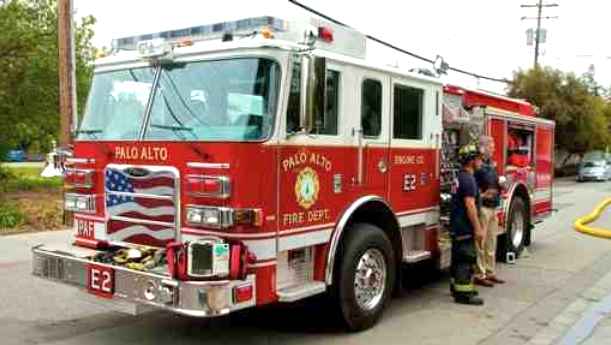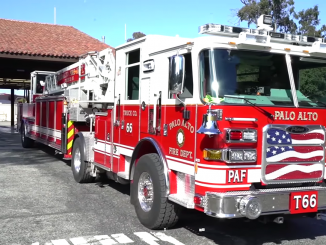
BY DAVE PRICE
Daily Post Editor
Palo Alto City Council members voted unanimously early yesterday morning (Oct. 17) to cut 11 Fire Department positions and they heard an explanation from Fire Chief Eric Nickel about the unusual nature of the Wine Country fires.
The cuts, to be made through attrition and not layoffs, will save the department $1.5 million annually. They’re in response to Stanford’s decision to reduce its payments to the city for firefighting and paramedic services by about $2 million a year.
Overshadowing the meeting were the fires in Sonoma, Napa and Mendocino counties that have killed 41 people and destroyed 6,000 homes and businesses.
Councilwoman Karen Holman asked Chief Nickel how the cuts will affect the city’s ability to fight fires in the hills.
“That was a very unique weather pattern,” Nickel said, referring to the Wine Country fires. It happened because of the alignment of the canyons and that the type of Diablo-style winds that hit Wine Country on the night of Oct. 8 descended to ground level.
“What was unique about this phenomena was that (the winds) surfaced, and the last time it surfaced to that magnitude was 1964.”
“Rarely do these winds get down to sea level,” he said.
“If that occurred here, whether I had six fire engines or whether I had the foothills fire station staffed, if I couldn’t get 500 fire engines within the first 10 hours, you’re going to get the same result. There’s nothing you can do to plan for an event of that magnitude,” Nickel told council.
“When that fire took off, 90% of the damage was done by sunrise. We would need literally hundreds of staffed fire companies on duty for that kind of wind event that so rarely occurs. It would cost so much that it’s impossible for any agency to staff up for something like that.”
Prevention
He said his department puts a strong emphasis on preventing wildfires, by telling property owners in the hills to clear vegetation near their homes to create as much defensible space as possible.
Nickel said the homes that were saved in Wine Country were generally those with defensible space.
Council, which began its discussion at 11:30 p.m. Monday and voted at 12:30 a.m. yesterday, heard from residents who opposed the cuts of four apparatus operators and seven firefighter-paramedics.
Some oppose cuts
Referring to the Wine Country fires and the Oakland Ghostship blaze, resident Neva Yarkin asked council to find another place in the city’s budget to make cuts.
“Palo Alto or any of our neighbors could be faced with the same major disasters,” Yarkin said. “Major disasters could include earthquake fires, a train derailment, a fire in the Palo Alto hills, a chemical explosion at Stanford or a company fire and will require emergency services for all of us. Major disasters don’t follow computer models. They can happen at any hour, anytime day or night. We need to be prepared.”
Fred Balin, another resident, said, “This plan … rests on a premise that a financial obligation (that) impacts all city departments should be disproportionately addressed — in of all places — public safety.
Chief Nickel said that through reassignments of personnel, two paramedics will still respond to every medical emergency, though they will arrive on different vehicles. He said the city will continue to reach 90% of medical emergencies in the urban and suburban areas of town within eight minutes. Response time would be 20 minutes in the hills.
The case for cost cutting
Councilman Eric Filseth said that while the cuts were prompted by Stanford’s decision to reduce its payments to the city for fire and paramedic service on campus, the cost of all city services is escalating beyond expected increases in revenues.
“We’re not going to be able to continue to afford the level of services that we’ve become accustomed to without some optimizations,” Filseth said. “So if we’re going to preserve our services in general, we have to find a way to deliver them more efficiently.”
Stanford decided to cut its payments after the city closed one of the two fire stations on university property.
No firefighters or leaders of their union spoke to council before the vote. But on Oct. 6, Battalion Chief Ryan Stoddard, president of the International Association of Firefighters Union Local 1319, said the danger of the chief’s proposal is its reliance on “cross-staffing,” reducing the typical crew of three on a fire engine and two on an ambulance to a single three-person crew manning both. Each fire station typically has three to eight personnel during the day.
“We think it’s very unsafe,” Stoddard told the Post on Oct. 6. “We’re already doing a lot more with a lot less equipment. It just becomes a gamble at some point.”
But City Manager Jim Keene told council the cuts were carefully considered. “I do not think you’ll see any diminution of service,” Keene said.



